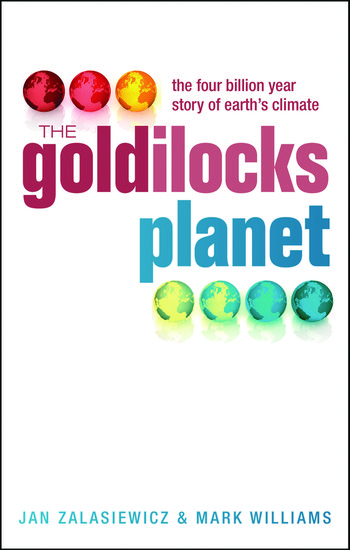By Jan Zalasiewicz and Mark Williams
Imagine that time machine has finally been invented. All of the ancient Earth can now be visited. One could experience the world as it was: see long-dissipated cloud systems with one’s own eyes, feel ancient rain and primeval winds, and sense the warmth of prehistoric sunshine on one’s back. A safari into the ancient past with just 5 stops were allowed. Where would one choose to go?
Even today, we have a huge range of climate on Earth, from poles to equator, from bone-dry desert to steamy jungle. But, back in the deep past, one might see sights far stranger, beyond even the dreams (and nightmares) of Hollywood.
For the first stop, let us take a journey back close to the beginning of the Earth, to the early Archaean, nearly four billion years ago. We would need something like a space suit, for then the atmosphere had no oxygen. How to regulate the thermostat? There is tantalizing evidence — controversial, disputed evidence — that the world might, then, have sweltered at nearing eighty degrees Celsius. Be careful as you open those time-machine doors!
For the second stop, the opposite extreme. Go armed with the warmest of arctic gear — in triple layers, at least. Fast forward to three-quarters of a billion years ago. The Earth went through deep freezes more intense than anything before or since. It would be marvellous to cautiously explore that long-gone planet. Was there really, as some scientists now say, a worldwide carapace of ice, both land and sea, with no evaporation, clouds, rain, nor snow? In such a world, the hydrological cycle would be stilled. A brilliant blue sky would hang endlessly above the gleaming ice. Or were there (as some say) patches of frigid open water to spawn small weather systems? If so, this would be a world of slush as well as ice.

Stop three. Well, obviously, we need to go back to the dinosaurs, only a hundred million years ago or so. There, once one has gazed at those ‘terrible lizards,’ take a trip to the arctic circle to find not ice but green forests, of conifer, cycad, and monkey-puzzle tree. Inhabitant dinosaurs adapted to living half the year in darkness, and half in day-round light. How did this greenhouse world function, and how did the polar regions stay so warm? We still don’t quite know.
Stop four. Let’s go for drama. The last ice ages, just a few tens of thousands of years ago, weren’t just cold. They were violent. Order the time-ship to hover in the sky above north America, at, say, 13,000 years ago. One would see a mighty ice-dam bursting and a lake greater than all the Great Lakes put together pour in an awesome torrent into the sea, scouring the land as it roars along. After a couple of weeks of this, sea level is metres higher. The inrush of icy waters have stilled warmth-providing ocean currents, and the temperature now drops like a stone. Best reach for that life-saving warm fleece.
Stop five must be… the future, perhaps in a thousand years time. What would one see, then? The smart money is on the world going back to a state like the Pliocene Epoch, five million years ago: warmer than today, with less ice. One might snorkel, for instance, over the drowned cities of 21st century civilisation…
Alas! A time machine seems to be impossible, but adventure is not. The real high excitement comes in working out what the world was like long ago from the evidence that lies hidden within ancient rock strata. It’s a real detective story, a whodunit stretching back more than four billion years. It might help us, too, to glimpse our future.
Jan Zalasiewicz is Senior Lecturer in Geology at Leicester University. He is the author of The Earth After Us and The Planet in a Pebble. Mark Williams is Reader in Geology at Leicester University. Both are established researchers into palaeoclimates and climate change. Together, they are the authors of The Goldilocks Planet: The 4 Billion Year Story of Earth’s Climate.
Subscribe to the OUPblog via email or RSS.
Subscribe to only environmental and life science articles on the OUPblog via email or RSS.
View more about this book on the ![]()
![]()


[…] The link went to a blog post at the Oxford University Press blog (the publishers), with the title “Time-travelling to distant climates”. The science fiction angle in that title got my interest. And the blog post, written by the authors […]
I just published a review of your book on my blog and submitted it to Amazon as well. It is at the top of a Google search for “Goldilocks Planet review” right now.
[…] Audio clip: Adobe Flash Player (version 9 or above) is required to play this audio clip. Download the latest version here. You also need to have JavaScript enabled in your browser. Jan Zalasiewicz is Senior Lecturer in Geology at Leicester University. He is the author of The Earth After Us and The Planet in a Pebble. Mark Williams is Reader in Geology at Leicester University. Both are established researchers into palaeoclimates and climate change. Together, they are the authors of The Goldilocks Planet: The 4 Billion Year Story of Earth’s Climate. Read their previous blog post “Time-travelling to distant climates.” […]
[…] Click here to read the authors’ recent post on Oxford University Press’ blog. […]
[…] the ground we walk and live upon got to do with it? The best way to find out is to head back to the transition from icehouse to greenhouse that followed the end of the last ice age. As the world warmed dramatically between about 18,000 […]